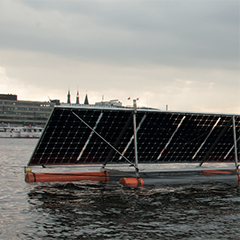In a drive for even lower costs and higher efficiency, the photovoltaic industry is hugely dominated by the standard rectangular panels of 60 or 72 cells optimised for installation in large fields and flat roofs, in dry and accessible environments. This has proven a good model for utility-scale electricity production but people want more.
This is exemplified by Elon Musk’s announcement last year, that Tesla will market a solar roof tile, going viral; a demand exists for PV elements integrated into the environment around us—in ways that are efficient, economic, and beautiful.
Products for varied applications like PV roof tiles, PV building skins, floating PV, PV on landfills, and PV noise barriers are still required to be economic and manufacturable. The best system design choices for these products often require a novel module concept or set of materials.
Dutch energy research centre ECN has established the Solar Elements Living Laboratory (SELL) to work with customers to develop their custom-integrated PV products from the initial idea to market introduction.
Starting with economically and mass-manufactured solar cells or laminates, the SELL is equipped with tools and experts to design, prototype and test integrated PV products of all sizes, shapes, colours, and applications.



























